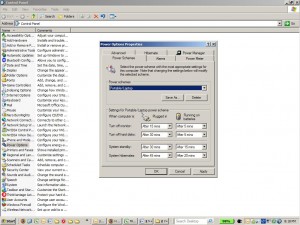by David Hakala
Laptop batteries require a bit more attention than flashlight batteries to extend their lives and maximize the power you get out of them. Most notebook computers come with battery and power consumption management software. Windows has a few tools built into it, too. Go to Start > Control Panel > Power Options.
If you operate off A/C power for prolonged periods, your notebook battery may be recharging too often. Every discharge/recharge cycle, no matter how small, reduces the battery’s power capacity. If your battery software is set to recharge when the battery’s power level hits 95%, a common default value, then the battery will recharge more often than if the recharge threshold was set at 50 or 40%. The battery can wear out just sitting in an A/C-powered notebook. So set the recharge threshold lower if you don’t rely on battery power for more than an hour at a time.
A notebook battery can be permanently crippled if it is discharged all the way down to zero percent of capacity. That is one reason why Windows has low-battery alarms that can automatically take action to protect your battery as well as your data when battery power runs low. The Alarms tab on the Power Management Properties page is self-explanatory.
When your laptop battery finally wears down after 600 to 800 recharge cycles, you may be shocked by the price of a new replacement battery.
Used, refurbished, and remanufactured laptop batteries are widely available. Their prices are generally less than half that of new batteries. No, they don’t last as long as new batteries no matter what the sellers say. “Refurbished” generally means the old battery cells have been replaced with identical ones. “Remanufactured” often means the old cells have been replaced with newer technology of higher capacity.
David Hakala has perpetrated technology tutorials since 1988 in addition to committing tech journalism, documentation, Web sites, marketing collateral, and profitable prose in general. His complete rap sheet can be seen at http://www.linkedin.com/in/dhakala


{ 1 comment }
How do I set the battery’s recharge threshold lower to 10% ?
Comments on this entry are closed.